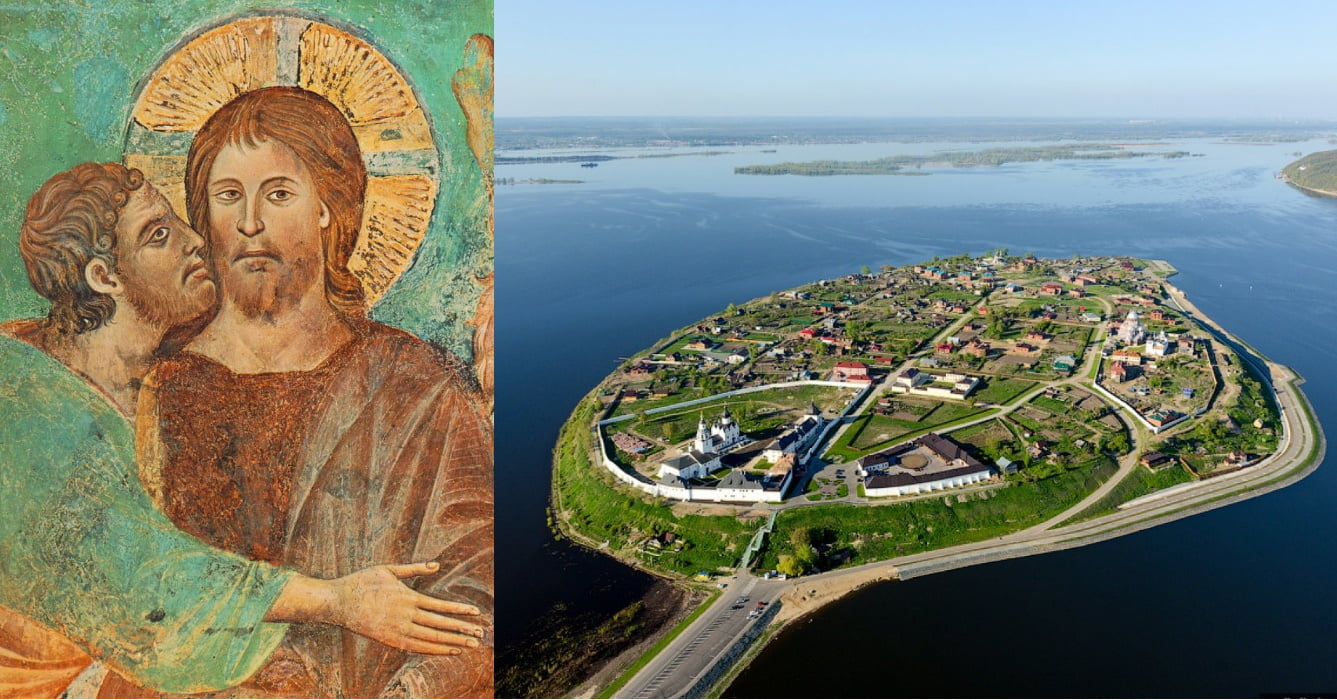A number of sources claim that in the first years of Soviet power, as part of the fight against religion, a monument to the apostle who betrayed Christ appeared in the country. We checked to see if this was the case.
Most stories about the appearance of the Russian Judas Monument involve Sviyazhsk - historically a city, and now a village on a Volga island 20 km from Kazan. That's it writes local historian Georgy Muller: “According to Lenin’s plan for monumental propaganda and the resolution of the Council of People’s Commissars, a commission headed by N.K. Krupskaya prepared a list of people from the historical past who, in the opinion of the Bolsheviks, “deserve gratitude from the revolution.” <...> Among the people who received the attention of the Bolsheviks, along with the figures of the French revolution of the 18th century Danton and Robespierre, were Sophia Perovskaya and a strange figure shaking a finger at the sky... Judas Iscariot. Judas was added to the list of revolutionary figures by someone from Lenin’s circle. He was supposed to personify, according to the Bolsheviks, the first fighter against religious obscurantism.
Several dozen boxes with figurines of “revolutionary rebels” - from Judas Iscariot to Stepan Razin and Emelyan Pugachev - were carried by a special freight car attached to Leon Trotsky’s armored train. Now it is difficult to say why the monument to Judas the Seller of Christ was erected specifically on the Sviyazhsk Peninsula. Perhaps he simply fell into the hands of the Red Guards and sailors?..
The town of Sviyazhsk became the first on the list of Russian settlements marked with monuments to the revolution. An eyewitness to the installation of the plaster idol of Judas, a certain A. Karaksin, wrote in the brochure “On the Roads of Russian Troubles,” published in the 20s in Berlin, that this monument was installed on the island by sailors of the Volga military flotilla immediately after the capture of Kazan.
<…>
On the morning of September 6, the Red Guards left the island, and in the evening of the same day, the residents smashed the image of Judas to smithereens. The second plaster Judas, similar to the one in Sviyazhsk, was, according to recollections, installed by the Revolutionary Military Council in Tomsk.”
Reports of the Judas monument in Soviet Russia are often found in fiction (for example, in the works 1931, 1939 And 1953 years), and the lion's share here is emigrant prose. In Soviet journalism, where there could and should have been the most complete information about such structures, they are practically absent.
In July 1919, the newspaper “Izvestia of the Petrograd Council of Workers and Red Army Deputies”, in an article under the heading “Crusade against workers and peasants,” reprinted excerpts from Kolchak’s newspapers “Siberian Shooter” and “Great Russia” (there is no copy on the Internet): “Monument to Judas Iscariot. Omsk, May 5. According to Soviet newspapers, the executive committee of the Tambov council decided to erect a monument to Judas Iscariot in Tambov.”
As you can see, the information here is also based on anti-Soviet publications. There are only two relatively detailed sources of information about the Soviet monument to Judas.
1) The brochure of the emigrant writer A. Varaksin (named Karaksin in the Muller quote above) “On the Roads of Russian Troubles,” allegedly published in Berlin in 1923 and today available only in the form excerpts.
2) And the main source: the book of memoirs of the Danish diplomat Henning Köhler “Red Garden" Chapter about Sviyazhsk, the text of which is available today in two parts, is based, according to the author, on his trip to the city in 1918.
The Prague newspaper Church Gazette, published in December 1923, refers to Köhler:

As we can see, here the authors of the article are not sure of the reliability of Koehler’s words. But there are other circumstances that make us doubt. Namely:
— the absence of any information about the monument to Judas in Sviyazhsk in Soviet documentary sources;
— the author’s action takes place in a city called Sviagorod. He became Sviyazhsk only in translations;
— confusion with dates and directions of Kohler's travel;
- How admitted Köhler himself in 1943, in response to accusations of fiction and plagiarism, “memories are artistically processed, condensed and intensified. Each of them contains a lot of experience, but they should be perceived as a work of art”;
— the coincidence of the installation of the monument with the funeral of a prominent Soviet brigade commander Yana Yudina, who died nearby. After his death, his body was sent to the Sviyazhsk station and buried behind the railway tracks. The monument erected on the grave was engraved: “Yan Yudin, commander of the left bank group of the Red Army for the defense of Kazan, and his orderly, who died in the battle for Kazan on 12–8–1918.” Today there is no monument, and the remains of the commander were moved to the village of Yudino. Perhaps it was precisely the presence of a certain Yudin during the installation of the tombstone that seemed to Keller, who had little understanding of what was happening, as phantasmagoric blasphemy;
- V resolution The Council of People's Commissars dated July 30, 1918 contains the same list of people to whom monuments should be erected in the USSR. Judas is not among them.
As for Varaksin’s brochure, there is no information about it in database “International Union Catalog of Russian Books, 1918–1926”, where almost all the information about publications of the Russian diaspora of those years is collected.
In confirmation of the events described by Köhler, we have, in fact, only two things. Firstly, counts proved that the diplomat actually came to Sviyazhsk in the spring and summer of 1918, although this does not provide any information about the monument itself. Secondly, social networks write about a certain old woman Kurashova, who as a child allegedly saw a monument to Judas in Sviyazhsk, and a wooden one at that. Kurashova died around 2007, so it’s impossible to get a comment from her.
Thus, the story about the monument to Judas in Sviyazhsk has many more facts against it than facts for it. There is no detailed information at all about monuments in other cities.
Most likely not true
Read on topic:
If you find a spelling or grammatical error, please let us know by highlighting the error text and clicking Ctrl+Enter.







